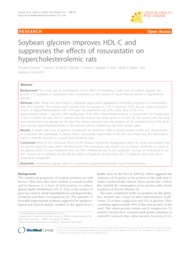Soybean glycinin improves HDL-C and suppresses the effects of rosuvastatin on hypercholesterolemic rats.
Soybean glycinin improves HDL-C and suppresses the effects of rosuvastatin on hypercholesterolemic rats.
Author(s): FASSINI, P. G.; NODA, R. W.; FERREIRA, E. S.; SILVA, M. A.; NEVES, V. A.; DEMONTE, A.
Summary: Background: This study was an investigation of the effects of ingesting a daily dose of isolated glycinin soy protein (11S globulin), in association with rosuvastatin, on the control of hypercholesterolemia in experimental animals. Methods: Male Wistar rats were kept in individual cages under appropriate controlled conditions of temperature, light and humidity. The animals were divided into five groups (n = 9): 1) standard (STD): fed on casein as protein source; 2) hypercholesterolemic (HC): STD plus 1% cholesterol and 0.5% cholic acid; 3) HC+11S: hypercholesterolemic + glycinin (300 mg/kg/day); 4) HC+ROS: hypercholesterolemic + rosuvastatin (10 mg/kg/day); 5) HC+11S+ROS: HC diet, the 11S protein and the drug in the doses given in (3) and (4). The protein and the drug were administered by gavage for 28 days. The results indicated that the addition of 1% cholesterol and 0.5% cholic acid induced hypercholesterolemia in the animals without interfering with their weight gain. Results: A single daily dose of glycinin contributed an additional 2.8% of dietary protein intake and demonstrated its functional role, particularly in raising HDL-C, decreasing triglycerides in the liver and improving the atherogenic index in animals exposed to a hypercholesterolemic diet. Conclusion: Most of the beneficial effects of the isolated treatments disappeared when the drug (rosuvastatin) and the protein (glycinin) were taken simultaneously. The association was shown not to interact additively, as noted in the plasma levels of total cholesterol and non-HDL cholesterol, and in the significant increase of cholesterol in the liver. Studies are in progress to identify the effects of peptides derived from the 11S globulin and their role in cholesterol metabolism.
Publication year: 2011
Types of publication: Journal article
Unit: Embrapa Maize & Sorghum
Keywords: Soja
Observation
Some of Embrapa's publications are published as ePub files. To read them, use or download one of the following free software options to your computer or mobile device. Android: Google Play Books; IOS: iBooks; Windows and Linux: Calibre.
Access other publications
Access the Agricultural Research Database (BDPA) to consult Embrapa's full library collection and records.
Visit Embrapa Bookstore to purchase books and other publications sold by Embrapa.

